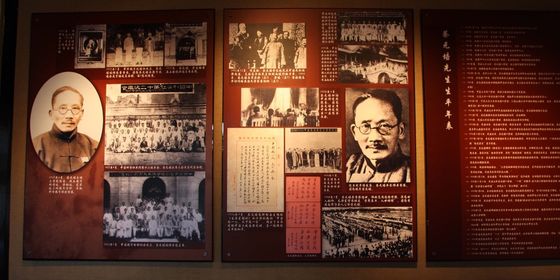For mainland fans of Traditional Chinese, character reforms are no joking matter
There’s an old joke in China: A team of researchers ask children from the Chinese mainland and Taiwan to write the phrase “melancholy Taiwan turtle” 100 times; the Taiwanese group gives up after a dozen tries, while the mainland kids persevere until the end.
Is the joke about differences in the education system? Are mainlanders less apt to rebel against pointless assignments? Were the Taiwanese kids upset that their turtles were sad? Actually, the punchline is because the two groups write their respective phrases like this:
忧郁的台湾乌龟 vs. 憂鬱的台灣烏龜
The difference in difficulty is immense. Some versions of the joke add “swinging on a swing” (蕩鞦韆), “provoked a flock of dirty, mutant snapping tortoises” (尋釁幾羣骯髒變態囓齒鱷龞) to the end of the phrase. The aim is to play up the contrast between the Simplified Chinese writing system (SC, 简体字) on the mainland and a few of the most difficult examples of Traditional Chinese characters (TC, 繁体字, “complex characters”) that are officially used in Taiwan (where it’s known as 正体字, “orthodox characters”) Hong Kong, Macau, and various diaspora Chinese communities.
But for many, the difference is no joke. In Chinese-speaking regions, the choice of writing system is less a mere act of removing strokes and saving time, than a conduit for differing values on education, national identity, and the preservation of traditional Chinese culture.
China is rightly proud of how it has raised its literacy rate from around 20 percent in 1949 to over 95 percent today, an achievement partly attributed to the standardization and simplification of the writing system since the language reforms of 1956 (though even this view has not gone unchallenged).
But those in TC-dominant regions, as well as a minority on the mainland, see the “pruning” of Chinese characters as showing disregard for history and culture. In February 2016, Hong Kong broadcaster TVB received a flurry of complaints for using SC subtitles, which, in tandem with a proposal by the city education bureau to introduce SC education to Hong Kong schools, struck at the heart of the Hong Kongers’ fears of the “mainlandization” of their society, political system, and culture. On the mainland, however, groups interested in promoting the greater use of TC have little room to rally formally, instead expressing their views in social media groups or, of course, using TC in their own daily life.
“It’s an ‘intangible cultural heritage item,’ a dying element of the nation; compared to Simplified, [TC] better reflects the nuances of Chinese culture,” Guangzhou fashion entrepreneur Mai tells TWOC. Watching Hong Kong TV was an easy way for many Cantonese speakers to pick up TC since childhood, she says; now she uses it not only in personal communication, but in her business. “I also personally like TC better.”
TC acolytes on the mainland are in good company—although the use of SC was legally mandated in 2001 by the General Language Law of the PRC—except in special circumstances such as calligraphy, cultural relics, or family names—proposals were raised at both the 2008 and 2009 sessions of the Chinese People’s Political Consultative Conference to reintroduce TC on the mainland, on the grounds that the original intent of language reform has been made moot by computerized input systems, as well as improvements in literacy and education. Meanwhile, the preservation of culture, understanding of ancient Chinese literature, and exchanges with Taiwan, Hong Kong, and TC-dominant diaspora regions are more pressing imperatives today.
These proposals were rejected, on the grounds that restoration of TC was not an urgent issue for Chinese society today.Celebrities who use TC for Weibo posts invariably provoke derision from netizens and even media—when actress Jiang Xin complained last year about background actors who violated her privacy, Weibo users were less interested in her plight than in the “pretension” of posting her complaint in TC. “Celebrity” exponents of TC, notably director Feng Xiaogang (also a CPPCC delegate), are meanwhile often accused of “elitism” by their opponents.
These criticisms echo views expressed by language reformers of the early 20th century, who argued that both China’s writing and formal grammar systems were holding back its modernization. In response, the Nationalist Party proposed in 1935 to give official status to simplified forms of 324 Chinese characters already in common use, for the sake of more efficient communication (simplification was also proposed in 1952 in Taiwan, but promptly shot down).
After the founding of the People’s Republic of China in 1949, the Communist Party (CCP) resumed these efforts by creating the Chinese Language Reform Association, which drafted the basic proposal behind the “Chinese Characters Simplification Scheme” of 1956. This recognized the simplified forms of 230 characters and 30 radicals as standard, and was followed by a second round of reforms in 1964 proposing 2,236 simplified characters, which remain the total of official simplified forms used on the mainland today.
The CCP reforms reduced the stroke count of many characters, removed non-standard characters and combined different TC characters into the same SC character: both 裏 and its non-standard form 裡, meaning “inside” (or kilometer), became 里, while “wheat noodle” (麵 in TC) now uses the same character as “surface” (面), leading to the occasional Chinglish.
Although simplification predates the founding of the PRC, it has since become shorthand for ideological disagreement between the PRC and other Chinese-speaking regions, as well as anxieties over the cultural and even moral decline of modern Chinese society. “You cannot say something is ‘dear’ [亲 in SC, 親 in TC] without ‘seeing’ [the 見 radical]; if you listen [听 in SC, 聽 in TC] with a mouth [口 radical] instead of ears [耳 radical], then you lack understanding and reflection over what you say,” argues Man, another mainland TC-user from Guangzhou. “This is why I persevere with TC.”
Feng expressed a similar idea ahead of the 2015 CPPCC, repeating his claim that “you cannot have love [爱 in SC, 愛 in TC] with no ‘heart’ [心].” In Hong Kong, the most fanatical critics of TVB’s so-called “character assassination” decision stereotype SC as being part of the cult of extremism that contributed to the Cultural Revolution,
Supporters of simplification, on the other hand, point out that characters have always evolved throughout history: “Traditional” characters in Taiwan and Hong Kong simply refer to the writing systems standardized by their own respective governments and derived from kaishu (楷书), a system first developed in the Northern and Southern Dynasties (420-589) period. The many simplified forms used today were already in common use prior to 1956; indeed, some are restorations of early characters that have become more complicated over time. An attempt to introduce a third round of reform in 1977 failed, in fact, because the proposed simplifications were not already in common use.
On the mainland, there are apps and input systems now available to transform SC messages to TC—although glitches in the software can produce humorous translation errors—comparable to “Chinglish” on Chinese-English bilingual signs—or insert rare, non-standard, or unnecessary TC that wouldn’t be used by a fluent writer in Hong Kong or Taiwan (the mutant tortoises from earlier, for example, would more likely have been 尋衅幾群骯髒變態嚙齒鰐亀).
At the 2015 CPPCC, Feng the director noted that familiarity with TC, stripped of politics and class, still has the tangible benefit of making ancient historical texts and classical literature more widely read. Unlike his predecessors at the 2008 and 2009 CPPCC, he didn’t advocate for replacement of SC or even propose the teaching of both systems simultaneously—but only the teaching of 50-200 “meaningful” characters in school.
But for many fans of TC, it’s not enough to compromise. “If a customer can’t read Traditional and asks me to rewrite something in Simplified, I’d answer—‘as a Chinese person, you may not be able to write in Traditional, but it’s unacceptable to not understand it,” Mai says. “As someone able to use it fluently, I feel like I should do my part in ensuring the continuity of this culture.”












